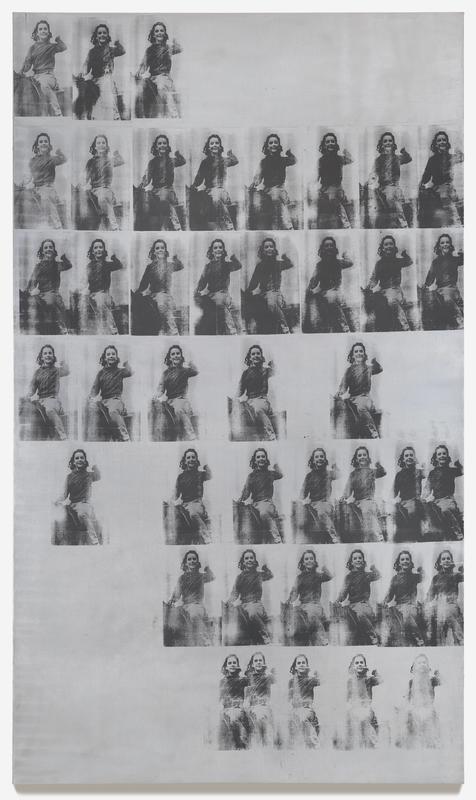More about National Velvet

Sr. Contributor
Andy Warhol, the king of pop art, painted National Velvet in 1963.
It is comprised of multiple adolescent Elizabeth Taylors on horseback, based on a Life magazine photograph of Taylor on the set of the film with the same name. In his Death and Disaster series, Warhol often used tragic starlets and socialites as subject matter, including Taylor along with Marilyn Monroe and Jackie Kennedy. At the time Warhol was working on the painting, Taylor was rumored to be dying from cancer in London. He was fascinated with Taylor’s celebrity, especially her many brushes with death, and created over fifty works with Taylor as the subject in his lifetime.
In the film "National Velvet," Taylor portrays a young girl living in Sussex, England, training her horse to compete in the Grand National competition. It is cited as Elizabeth Taylor’s breakout role. The film was generally received well by critics; the Guardian called the plot “fresh” and the Nation’s James Agee remarked on how she was “rapturously beautiful” even though he stated that she wasn’t a “particularly gifted actress." Remarks on Taylor’s beauty were a recurring theme. The New York Times’ Bosley Crowther commented that her “face is alive with youthful spirit, her voice has the softness of sweet song and her whole manner in this picture is one of refreshing grace." "National Velvet" was nominated for three Academy Awards and became one of the first films selected by the Library of Congress for their motion picture collection.
In National Velvet (the artwork), Warhol chooses to depict Taylor on black paint over a silver silk screen background as a nod to the term “silver screen.” It features a young Elizabeth Taylor in her first leading role at the age of only twelve in 1944. It shows a prepubescent Taylor, youthful and spirited, a classic symbol of virginal, rosy-cheeked beauty, instead of the seductress she is painted as after her career-changing role in the movie "Cleopatra." Her role as Cleopatra in the film "Cleopatra" in 1961 was the beginning of her commodification and sexualization by the media. Taylor had scandalous extramarital affairs with married singer Eddie Fisher and her co-star Richard Burton during its filming. That, combined with the unfavorable reception by film critics who called her too fat, her voice too thin, and her performance in "Cleopatra" altogether vulgar, marked the transformation of her public persona from child star to sex symbol.
Warhol uses the silk screen to show her transformation from woman to public property. Her public image is a mask, and the viewer is unable to see behind it to discern where the mask is and where the person begins. It is a commentary on celebrity culture which turns celebrities into a machine product, sold as commercial property. Warhol often critiqued the consumer exploitation and dispensability of fame through his portraits of public figures.
National Velvet is currently located in the San Francisco Museum of Modern Art, where it was acquired in 1993. Its sale by the Andy Warhol Foundation for the Visual Arts was contested by the Museum of Modern Art in New York. It is undisclosed how much SFMOMA paid for it, but Christie’s appraisal puts its value puts it at $1.2 million.
Sources
- Agee, James. “Elizabeth Taylor in ‘National Velvet’.” The Nation.
- Baker, Kenneth. “Andy Warhol's 'National Velvet'.” SF Gate. March 14, 2010. https://www.sfgate.com/entertainment/article/Andy-Warhol-s-National-Vel…
- Bergin, Paul. "Andy Warhol: The Artist as Machine." Art Journal 26, no. 4 (1967): 359-63. doi:10.2307/775065.
- Callens, Johan. "The Wooster Group's Hamlet, According to the True, Original Copies." Theatre Journal 61, no. 4 (2009): 539-61. http://www.jstor.org/stable/40660551.
- Crowther, Bosley. “'National Velvet,' Color Film, With Rooney and Elizabeth Taylor, at Music Hall -- 'Tall in Saddle' Comes to the Palace.” December 15, 1944.
- Peraino, Judith A. "Plumbing the Surface of Sound and Vision: David Bowie, Andy Warhol, and the Art of Posing." Qui Parle 21, no. 1 (2012): 151-84. doi:10.5250/quiparle.21.1.0151.
- “National Velvet (1945).” American Film Institute. https://catalog.afi.com/Catalog/moviedetails/24097
- “National Velvet.” The Guardian. October 9, 1945. https://www.theguardian.com/film/filmblog/2011/mar/24/elizabeth-taylor-…
- Vogel, Carol. “Inside Art.” New York Times. December 17, 1993.













